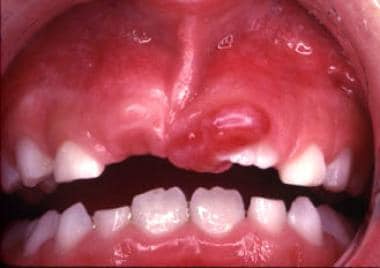Background
The peripheral giant cell granuloma has an unknown etiology, with some dispute as to whether this lesion represents a reactive or neoplastic process. However, most authorities believe peripheral giant cell granuloma is a reactive lesion. [1] See the image below.
Etiology
The cause of peripheral giant cell granuloma is unknown, although local irritation due to dental plaque or calculus, periodontal disease, poor dental restorations, ill-fitting dental appliances, or dental extractions has been suggested to contribute to the development of the lesion.
Reports have described the development of the peripheral giant cell granuloma in association with dental implants. This appears to represent an uncommon complication of implant placement, developing from a few months to several years after placement of the dental implant. [2, 3, 4, 5]
Epidemiology
Frequency
Peripheral giant cell granuloma is uncommon but not rare. Precise estimates of its incidence and prevalence in the general population have not been definitively determined.
Race
No known racial predilection is associated with peripheral giant cell granuloma.
Sex
One large recent study showed essentially no sex predilection (52% female vs. 48% male).
Age
A wide age range of patients can be affected, although most patients are in the fifth to seventh decades of life at the time of diagnosis of this lesion. One institutional biopsy service reported the mean age of 235 patients with peripheral giant cell granuloma to be 46 years, with a range from 6-88 years.
Prognosis
Peripheral giant cell granuloma has an excellent prognosis. A recurrence rate of 10-20% has been reported in most series; however, recurrences are typically managed easily with additional surgery. Some investigators have suggested that peripheral giant cell granulomas that develop in association with dental implants seem to have a higher risk for recurrence. [6]
-
A 10-year-old boy developed this painless purple papule of the maxillary facial alveolar process over a 3-month period. Biopsy helped confirm the diagnosis of peripheral giant cell granuloma.
-
This peripheral giant cell granuloma involved the maxillary gingiva associated with an erupting central incisor of a 6-year-old girl. The referring doctor had suggested a diagnosis of eruption cyst; however, an eruption cyst would immediately collapse once the tooth had disrupted its roof.
-
This asymptomatic bluish-purple nodule developed on the edentulous mandibular alveolar ridge of a 76-year-old man.






